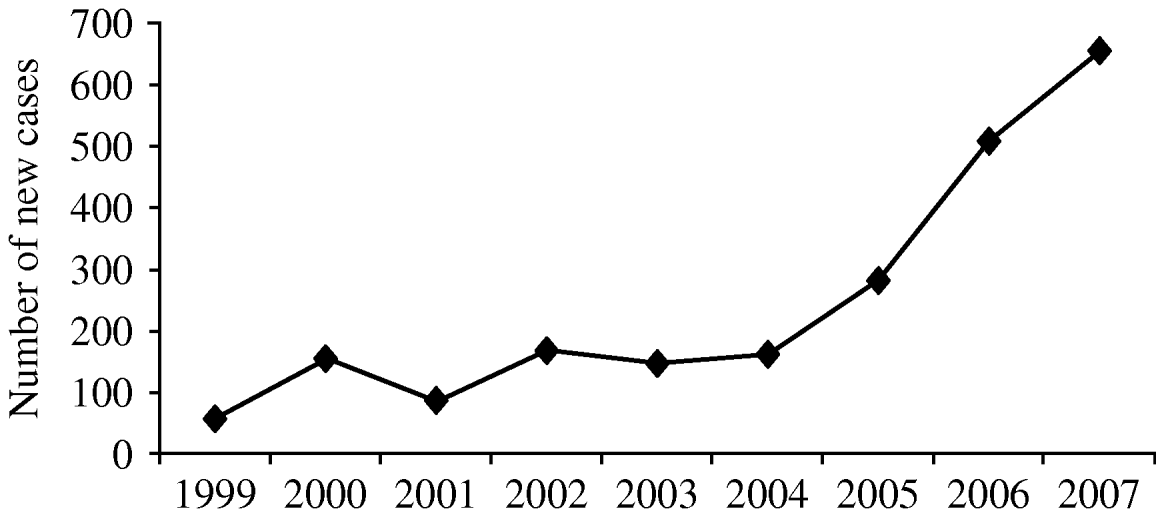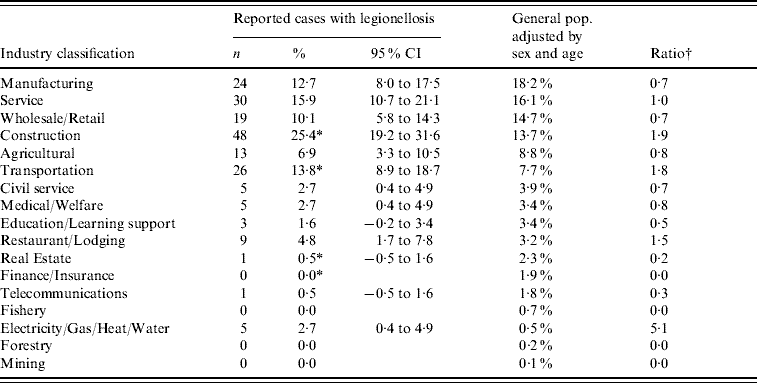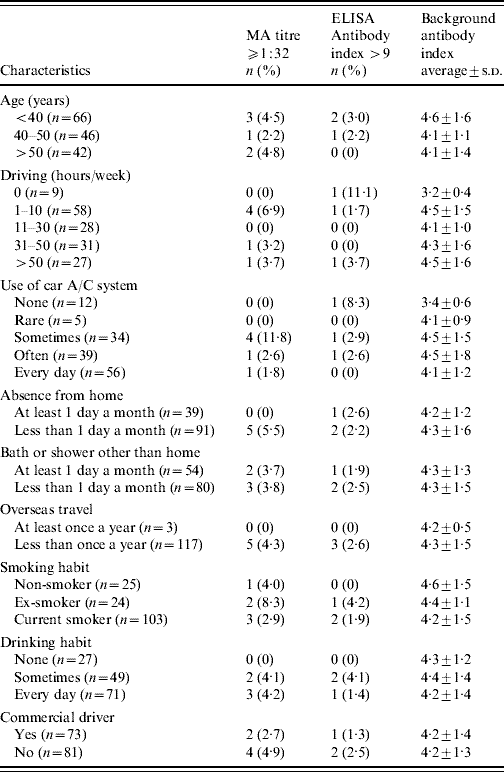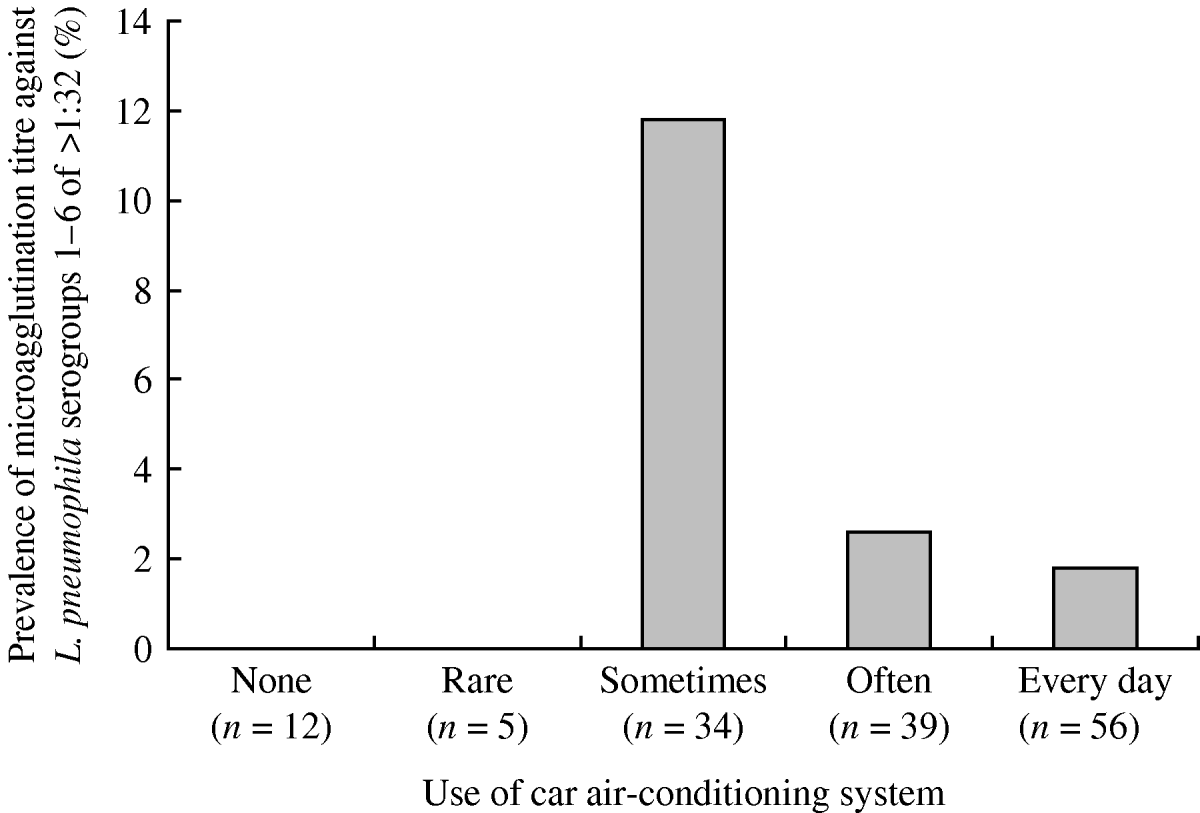INTRODUCTION
Legionella spp. are ubiquitous in our environment. Legionnaires' disease (LD) accounts for 2–15% of community-acquired pneumonia (CAP) requiring hospitalization and is one of three major causes of severe CAP [Reference Muder, Yu and Fang1]. In October 2005 guidelines for the management of CAP in adults were issued by the Japanese Respiratory Society, which called for testing by Legionella urinary antigen of all adult patients with CAP who require hospitalization [2]. The number of reported legionellosis cases in Japan increased markedly after the report was published. Although all legionellosis cases must be reported to local health agencies, only 655 cases were reported in 2007 (Fig. 1). It is possible that >10 times this number were undiagnosed or unreported in Japan. LD can be acquired by inhalation of aerosols containing Legionella spp. or by microaspiration of water contaminated with Legionella spp. Cases have been associated with potable water, cooling towers, water taps and showers, humidifiers, whirlpool baths, spas, medication nebulizers, and potting soil [Reference Fliermans3–Reference Diederen6]. Nevertheless, the source and mode of transmission are not always clear, especially in sporadic cases [Reference Bhopal7].

Fig. 1. Numbers of reported cases with legionellosis in Japan. Data obtained by the National Epidemiological Surveillance of Infectious Diseases. Data based on reports received before 1 November 2007.
We investigated a case of LD in a commercial truck driver [Reference Sakamoto8]. Since the patient's truck was serviced at a garage including the air-conditioning unit, we took a swab from the aluminium heat-exchanger fins of the evaporator to check for Legionella spp. by the loop-mediated isothermal amplification (LAMP) method. The swab was positive for Legionella spp.
Boer et al. [Reference Boer, Nijhof and Friesema9] conducted a prospective case-control study and reported that professional drivers were about three times more likely to develop sporadic community-acquired LD than the general public. Pinar et al. [Reference Pinar10] described a patient with LD in whom transmission possibly occurred through water leakage from the malfunctioning air-conditioning system of a car. Polat et al. [Reference Polat11] reported a seroprevalence of L. pneumophila serogroups (sg) 1–14 in 19% (12/63) of Turkish bus drivers, while all drivers' assistants were negative.
In the present study, we hypothesize that driving cars increases the risk of infection by Legionella spp. To test this, evaporator compartments of the air-conditioning systems were collected from scrapped cars for analysis of Legionella spp. The national database for legionellosis was analysed, and serum antibody to L. pneumophila sg 1–6 was tested for in healthy subjects who were mainly employees of regional transportation companies.
METHODS
Investigation of scrapped cars
In October 2006, the evaporator sections of air-conditioning systems were manually dismantled from scrapped/wrecked cars housed at a commercial car-recycling firm. Swabs were taken from the aluminium heat-exchanger fins of evaporators and examined for Legionella spp. by culture and LAMP kits (Eiken Chemical, Japan) (Fig. 2). The LAMP reaction causes turbidity attributed to a byproduct, magnesium pyrophosphate, in the reaction tube and the turbidity is proportional to the amount of DNA amplified. The turbidity in the reaction tube was checked visually by two researchers [Reference Annaka12, Reference Mori, Hirano and Notomi13].

Fig. 2. (a) A car air-conditioning system (arrow), and (b) the evaporator of a car air-conditioning system.
Analysis of the national database for legionellosis
We analysed the national database for legionellosis. Since April 2006, the occupation of each patient is reported to the Infectious Disease Surveillance Centre (IDSC), the National Institute of Infectious Diseases (NIID), by local health agencies. We compared the percentage of people working in the transportation industry within the group of patients with legionellosis with the percentage in the general population in 2005. The occupational structure of the general population was adjusted by age and sex to the legionellosis group.
Measurement of serum antibody
The subjects of this study were male participants of annual health check-ups conducted by a local medical centre during 5 days in summer. The time of the study was scheduled to coincide with the expected date of visits to the clinics by large number of employees of four transportation companies, a wholesale company and a construction company. Each individual completed a questionnaire on the potential risk factors for LD such as smoking, alcohol consumption, underlying diseases, driving time, the use of car air-conditioning systems, opening of windows during driving, and the frequency of travel. The responses to the question on the frequency of using car air-conditioning included five options: ‘None’, ‘Rare’, ‘Sometimes’, ‘Often’, and ‘Every day’. Blood samples were obtained after receiving informed consent and analysed for antibodies to L. pneumophila sg 1–6 by using a microplate agglutination (MA) test kit (Denka Seiken, Japan) [Reference Yabuuchi14, Reference Klein, Jones and Feeley15] and L. pneumophila sg 1–6 by enzyme-linked immunosorbent assay (ELISA) kit for IgG plus IgM (Vircell, S.L., Spain) [Reference Rojas16, Reference Diederen, Kluytmans and Peeters17]. The results were interpreted in accordance with the manufacturer's instructions. The Vircell IgG and IgM ELISAs are supplied as positive/negative qualitative assays using a screening dilution of 1:20. A negative result was indicated by an antibody index of <9 at a dilution of 1:20, and a positive result by an antibody index of >11 at a dilution ⩾1:20.
The study protocol was approved by the Ethics Review Committees of the Toho University School of Medicine and the Faculty of Medicine, Kyoto University.
Statistical analysis
Data are expressed as mean±s.d. The 95% confidence intervals (CI) were calculated for all risk ratios and a two-tailed P value of <0·05 was considered as statistically significant. All analyses were conducted using SPSS version 15.0 (SPSS Inc., USA).
RESULTS
Detection of Legionella spp. in car evaporators
Of the swabs taken from the evaporators, 11/22 (50%) proved positive for Legionella spp. by the LAMP method. On culture, the specimens were unfortunately beyond recognition because colonies of other bacteria covered the plate despite heat and acid treatments.
Analysis of the national database of legionellosis
Based on the IDSC database, 527 patients with legionellosis were reported from April 2006 to March 2007. Of these, 249 (47·2%) were unemployed (including retired people) and the employment of 89 (16·9%) was not reported. We analysed the occupational structure of the remaining 189 cases (35·9%) whose occupation could be classified. Transportation industry workers constituted 13·8% (95% CI 8·9–18·7) of the cases; this was significantly higher than the expected percentage of transportation industry workers (7·7%) in the general population after adjustment for age and sex (Table 1).
Table 1. Occupational analysis of 189 reported cases with legionellosis in Japan

Legionellosis data were obtained by the National Epidemiological Surveillance of Infectious Diseases. Data based on the reports received before 1 November 2007.
† Ratio of occupational structure of reported cases with legionellosis and general population adjusted by sex and age.
* P<0·05.
Serum antibody against L. pneumophila sg 1–6
In total, 159 men from regional companies underwent health check-ups. The participants consisted of 132 from transportation companies, 14 from a construction company and eight from a wholesale company. The response rate to the questionnaire was 98·7% (157/159), and 154 (96·9%) subjects consented to serological tests. The mean age of the subjects was 42·9±10·8 (range 25–70) years. Nine (5·8%) participants did not drive a car (defined as ‘non-drivers’) and 145 (94·2%) were current drivers that drove at least 1 hour a week (defined as ‘drivers’). The number of participants from transportation companies who drove more than 14 hours/week (defined as ‘commercial drivers’) was 73 (47·4%). Three subjects travelled overseas at least once a year and 39 were absent from home at least one day a month. Fifty-four participants took a bath or shower elsewhere than at home at least once a month. In all, 103 participants were smokers and 24 were ex-smokers; 71 consumed alcohol every day. None of the participants had received organ transplantation or was seriously immunocompromised (Table 2).
Table 2. Correlation between serum antibody to L. pneumophila serogroups 1–6 and various parameters

A/C, Air-conditioning; ELISA, enzyme-linked immunosorbent assay; MA, microplate agglutination; s.d., standard deviation.
None of the subjects had MA titres ⩾1:128 and one (0·6%) had a positive antibody index (>11) against L. pneumophila sg 1–6 by ELISA test kit. Six (3·9%) participants had MA titres of ⩾1:32 and two (1·3%) showed equivocal results [Reference Pinar10–Reference Annaka12] by the ELISA kit.
The mean background antibody index was 3·2±0·4 for non-drivers and 4·4±1·4 for drivers (P=0·007, Mann–Whitney test). There was no significant correlation between driving hours and background antibody index (r=0·05, P=0·546). In this study, overseas travel, absence from home, bath or shower at other than home, or smoking habit were not significant factors for higher background antibody against L. pneumophila sg 1–6, although these parameters are considered significant risk factors for LD [Reference Pinar10]. Regarding the frequency of use of car air-conditioning systems, the mean background antibody index was 3·4±0·6 for the ‘None’ group, including non-drivers, 4·0±0·9 for the ‘Rare’ group, 4·5±1·5 for the ‘Sometimes’ group, 4·5±1·8 for the ‘Often’ group, and 4·2±1·2 for the ‘Every day’ group (P=0·212, Kruskal–Wallis). The prevalence of MA titres ⩾1:32 was significantly higher only in participants who ‘sometimes’ used car air-conditioning (11·8%) than in the others (1·8%) including ‘None’, ‘Rare’, ‘Often’, and ‘Every day’ group (P=0·026, Fisher's exact probability) (Fig. 3).

Fig. 3. Prevalence of microagglutination titre against L. pneumophila serogroups 1–6 >1:32 according to the use of a car air-conditioning system.
DISCUSSION
The results of our study showed that Legionella spp. can be frequently detected in the aluminium heat-exchanger fins of car evaporators. From an analysis of the national database of legionellosis, the transportation industry appeared to constitute a high proportion of LD cases. The prevalence of MA titres ⩾1:32 was only significantly higher in subjects who ‘sometimes’ used car air-conditioning systems (11·8%). It was also higher than the prevalence of MA titres ⩾1:32 among healthy donors (2·1%) reported by Yabuuchi et al. in Japan [Reference Yabuuchi14].
We make three noteworthy points in this study. First, to the best of our knowledge this is the first report to describe the detection of Legionella spp. in car evaporators. Second, the high detection capability of the LAMP method allowed detection of the microorganism in samples contaminated with various bacteria and microbes, whereas culture of Legionella spp. or PCR in contaminated samples often resulted in failure. Third, the occupational structure of cases of legionellosis had been unknown in Japan before this study. From April 2006, the occupation of each case was added to the reports from the local health agencies. This means that the occupational structure of reported legionellosis cases can be analysed in Japan, while such analysis appears to be uncommon elsewhere in the world.
However, there were some limitations in this study. Our investigation does not prove a direct link between driving and LD. The finding of Legionella DNA in the samples might be from unculturable organisms and the viability of organisms could not be determined. In the national legionellosis database, a high proportion of legionellosis cases must be overlooked and unreported in Japan, as elsewhere. Thus, it is likely that we analysed only a small part of the occupational structure of potential legionellosis cases. The analysis did not take into account possible confounders such as smoking habits because information about smoking habits of cases is not currently required in the national database. Furthermore, examination was conducted 1 month after the onset of illness in our case. In our survey of the seroprevalence, we focused on drivers only. Passengers are also exposed to the air-conditioning system, but were not included in our study. This might have affected that study as the people classified in the ‘None’, ‘Rare’, and ‘Sometimes’ group may have been exposed as passengers.
Kumar and colleagues [Reference Kumar, Marier and Leech18–Reference Rose20] showed that moisture in car air-conditioning systems provided an environment suitable for microbial biofilm development and suggested that the microorganisms could be implicated in allergic reactions such as hypersensitivity pneumonitis in humans. The car air-conditioning system may act as a reservoir or a route for Legionella spp. There is no special filter between the evaporator and the driver compartment. In some vehicles, it is possible for Legionella spp. to be projected directly into the face of the driver from the air-conditioning system.
In a previous investigation, we analysed recently formed puddles of rainwater on asphalt roads and were successful in isolating L. pneumophila from 7/18 (39%) of them. This finding suggests that a car's air-conditioning can be contaminated through aerosols containing Legionella spp. from the roads. Analysis of the cooler outlets of the truck of the single patient described earlier was negative for L. pneumophila on culture, and we could not confirm the existence and viability of Legionella spp. To adapt to stressful environments, bacteria often enter a temporarily non-culturable state by regulating cell differentiation, although they can readjust later when the conditions become more favourable for growth. The presence of viable but non-culturable (VBNC) bacteria is well-known in L. pneumophila, especially under low temperature or low nutrient conditions [Reference Hussong21–Reference Ishimatsu25]. Acanthamoeba castellanii has been shown to resuscitate VBNC L. pneumophila [Reference Steinert26]. Simmons et al. [Reference Simmons27] isolated Acanthamoeba from aluminium heat-exchanger fins of cars. In a previous study, we demonstrated that at temperatures >25°C, L. pneumophila could replicate in amoebae, while at <20°C amoebae digested L. pneumophila and eliminated them through the process of encystations [Reference Ohno28].
Polat et al. [Reference Annaka12] reported a seroprevalence rate against L. pneumophila sg 1–14 of 19% (12/63) among bus drivers, while all drivers' assistants were negative. However, our analysis of serum antibody in 159 participants showed that the seroprevalence of L. pneumophila sg 1–6 was not significantly different in commercial drivers from others. Our results show that the prevalence was higher in participants who sometimes used car air-conditioning systems, suggesting that appropriate moisture and stagnation, which are necessary for colonization of Legionella spp., can be prevented by continuous flow of condensed water through the drain duct. Factors known to enhance colonization of L. pneumophila include humidity, warm temperatures (25–42°C), low flow, scale and sediment [Reference Borella4–Reference Bhopal7, Reference Ohno29]. The drainage duct of the air-conditioning unit is able to prevent colonization by Legionella spp. to a certain extent. Conversely, obstruction of the duct can cause water stagnation, which enhances colonization by Legionella spp. Indeed, the drainage duct of the truck driven by our patient was partially obstructed with scraps of styrofoam and ~130 ml water accumulated inside the air-conditioning unit.
To reduce the morbidity and mortality in patients with legionellosis, physicians should always consider the possibility of LD in patients with pneumonia. If driving is a potential risk for LD, not only commercial drivers but also other drivers seem to be at risk. Our results suggest the need for further analysis of the link between driving and LD. Awareness that Legionella spp. are ubiquitous in our environment is not sufficient – Legionella spp. exist in the cars we use in daily life.
ACKNOWLEDGMENTS
We express our gratitude to Ryoko Okuno and Masashi Koshimoto, Uji Sekiyu Corporation, and the Auto Centre Mori for cooperation in collecting the air-conditioning samples. We thank the National Institute of Infectious Diseases for providing data from the database. We acknowledge the work of the laboratory staff at Falco Life Science Ltd and Shionogi Biomedical Laboratories, Japan. We acknowledge the technical advice of Toshimitsu Annaka, Osamu Kubota, Ryo Miyake, Kenichi Souma, and Naoko Kinoshita. In addition, we also acknowledge the epidemiological advice of Masayuki Ishine, Yasuyo Ishimoto, and Mayumi Hirosaki.
DECLARATION OF INTEREST
None.









